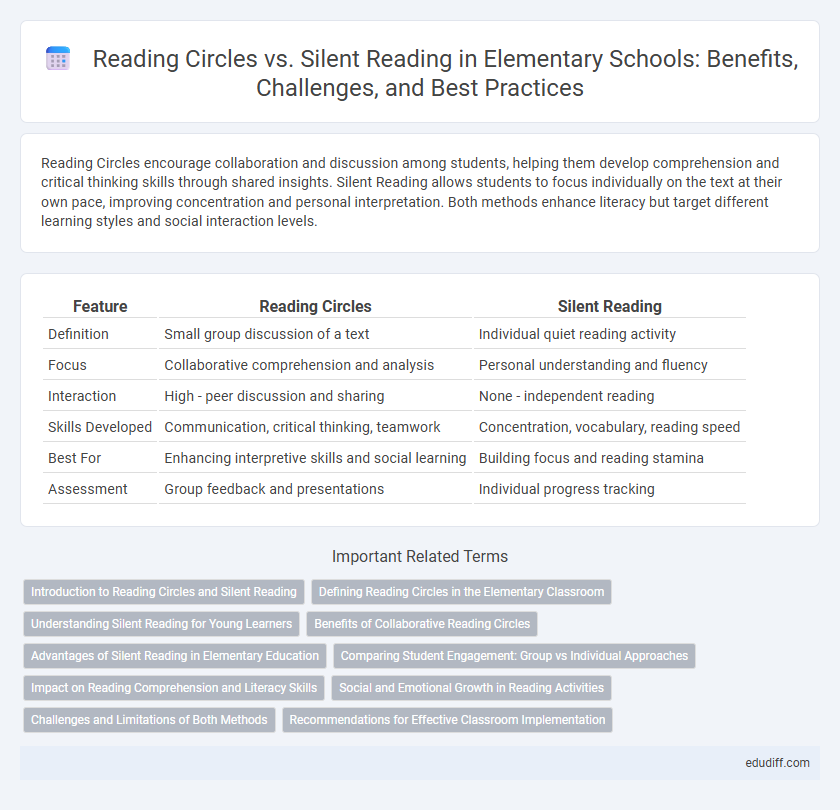Reading Circles encourage collaboration and discussion among students, helping them develop comprehension and critical thinking skills through shared insights. Silent Reading allows students to focus individually on the text at their own pace, improving concentration and personal interpretation. Both methods enhance literacy but target different learning styles and social interaction levels.
Table of Comparison
| Feature | Reading Circles | Silent Reading |
|---|---|---|
| Definition | Small group discussion of a text | Individual quiet reading activity |
| Focus | Collaborative comprehension and analysis | Personal understanding and fluency |
| Interaction | High - peer discussion and sharing | None - independent reading |
| Skills Developed | Communication, critical thinking, teamwork | Concentration, vocabulary, reading speed |
| Best For | Enhancing interpretive skills and social learning | Building focus and reading stamina |
| Assessment | Group feedback and presentations | Individual progress tracking |
Introduction to Reading Circles and Silent Reading
Reading Circles involve small groups of elementary students who take turns reading aloud and discussing the text, promoting comprehension and collaboration. Silent Reading allows children to independently engage with a book at their own pace, fostering concentration and personal interpretation. Both methods enhance literacy skills but cater to different learning styles and social interaction levels.
Defining Reading Circles in the Elementary Classroom
Reading circles in the elementary classroom involve small groups of students who read and discuss a shared book, enhancing comprehension through collaborative dialogue and role assignments such as summarizer or questioner. Unlike silent reading, reading circles promote active engagement, critical thinking, and social learning by encouraging students to express their thoughts and listen to peers. This interactive approach supports vocabulary development and deeper understanding of the text while building communication skills.
Understanding Silent Reading for Young Learners
Silent reading helps young learners develop independent comprehension skills by allowing them to process text internally at their own pace. Reading circles encourage discussion and collaborative understanding, but silent reading promotes individual focus and deeper mental engagement with the material. Research shows that regular silent reading improves vocabulary growth and reading fluency, critical components for early literacy development.
Benefits of Collaborative Reading Circles
Reading circles enhance comprehension by encouraging students to discuss and analyze texts collectively, fostering deeper understanding. Collaborative reading builds critical thinking and communication skills as children share diverse perspectives and clarify ideas. Group interaction in reading circles also boosts motivation and engagement, making reading a more enjoyable and social learning experience.
Advantages of Silent Reading in Elementary Education
Silent reading in elementary education enhances students' focus and comprehension by allowing personalized pacing and reducing distractions commonly found in group settings. It fosters independent fluency development and critical thinking skills by encouraging internal dialogue and self-monitoring during reading. This method supports diverse learning styles and helps build confidence as students engage with texts at their own level without peer comparison.
Comparing Student Engagement: Group vs Individual Approaches
Reading Circles promote student engagement through collaborative discussions, encouraging active participation and diverse perspectives in a group setting. Silent Reading allows individual focus, fostering personal interpretation and concentration without external distractions. Both approaches enhance literacy skills but cater to different learning preferences, balancing social interaction with independent comprehension.
Impact on Reading Comprehension and Literacy Skills
Reading circles promote active discussion and collaboration, enhancing reading comprehension and critical thinking skills among elementary students. Silent reading allows children to develop focus and fluency independently but may lack interactive elements that deepen understanding. Combining both methods encourages strong literacy skills by balancing engagement, interpretation, and self-paced practice.
Social and Emotional Growth in Reading Activities
Reading circles promote social interaction and empathy by encouraging students to share perspectives and communicate emotions during discussions. Silent reading supports individual emotional growth by allowing children to process stories privately, enhancing self-reflection and personal connection to texts. Combining both methods fosters a balanced development of social skills and emotional understanding in elementary students.
Challenges and Limitations of Both Methods
Reading circles can foster collaboration and discussion but may pose challenges like uneven participation and off-topic conversations among elementary students. Silent reading encourages focus and individual comprehension but might lead to disengagement and lack of immediate feedback. Balancing these methods requires addressing the social dynamics in reading circles and ensuring motivation during silent reading sessions.
Recommendations for Effective Classroom Implementation
Reading circles promote collaborative learning by encouraging students to discuss and analyze texts together, which enhances comprehension and critical thinking skills. Silent reading allows students to develop personal fluency and focus, making it important to allocate dedicated time for uninterrupted reading daily. Combining both methods by scheduling group discussions and individual reading sessions maximizes student engagement and literacy development in elementary classrooms.
Reading Circles vs Silent Reading Infographic

 edudiff.com
edudiff.com